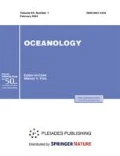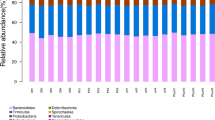Abstract
Dinoflagellate cysts were studied in 42 samples from the surface sediments of the White Sea. The total concentration of dinocysts varies from single cysts to 25 000 cyst/g of dry sediments, which reflects the biological productivity in the White Sea waters and the regional particular features of the sedimentation processes. The highest concentrations are observed in silts; they are related to the regions of propagation of the highly productive Barents Sea waters in the White Sea. Generally, the spatial distribution of dinocysts species in the surface sediments corresponds to the distribution of the major types of water masses in the White Sea. The cysts of the relatively warm-water species (Operculodinium centrocarpum, Spiniferites sp.) of North Atlantic origin that dominate in the sediments indicate an intensive intrusion of the Barents Sea water masses to the White Sea along with hydrological dwelling conditions in the White Sea favorable for the development of these species during their vegetation period. The cold-water dinocyst assemblage (Islandinium minutum, Polykrikos sp.) is rather strictly confined to the inner parts of shallow-water bays, firstly, those adjacent to the Onega and Severnaya Dvina river mouths.
Similar content being viewed by others
References
A. D. Dobrovol’skii and B. S. Zalogin, Seas of the USSR (Mosk. Gos. Univ., Moscow, 1982) [in Russian].
The White Sea: Biological Resources and Problems of Their Rational Use, Part 1 (ZIN RAN, St. Petersburg, 1995) [in Russian].
Yu. A. Bobrov, M. P. Maksimov, and V. M. Savinov, “Primary Production of Phytoplankton,” in The White Sea: Biological Resources and Problems of Their Rational Use, Part 1 (ZIN RAN, St. Petersburg, 1995) pp. 92–114 [in Russian].
The Seas of the USSR. Hydrometeorology and Hydrochemistry of the Seas. Vol. II. The White Sea, Issue 1, Hydrometeorological Conditions, Ed. by B. Kh. Glukhovskoi, (Gidrometeoizdat, St. Petersburg, 1991) [in Russian].
L. S. Zhitina and G. E. Mikhailovskii, “Ice and Planktonic Flora of the White Sea as an Object gfor Monitoring,’ in Biological Monitoring of Near-Shore Waters of the White Sea (Inst. Okeanol., Ross. Akad. Nauk SSSR, Moscow, 1990), pp. 41–49 [in Russian].
L. V. Il’yash, L. S. Zhitina, and V. D. Fedorov, Phytoplankton of the White Sea (Yanus-K, Moscow, 2003) [in Russian].
L. V. Il’yash, T. I. Kol’tsova, K. K. Sarukhan-Bek, et al., “Ecological-Coenotical Strategies of the White Sea Phytoplankton,” Vestn. Mosk. Univ., Ser. 16. Biology, No. 2, 24–31 (1999).
I. A. Kiselev, “Features of Phytoplankton Distribution in the White Sea,” in Materials of Multidisciplinary Studies of the White Sea (Akad. Nauk SSSR, Moscow, 1957), No. 1, pp. 282–304 [in Russian].
G. V. Konovalova, Dinoflagellates (Dinorhuta) of the Far East Seas of Russia and Adjacent Areas of the Pacific Ocean (Dal’nauka, Vladivostok, 1998) [in Russian].
B. I. Koshechkin, “Recent Structure Pattern of the Northeastern Part of the Baltic Crystalline Shield,” in Nature and Economy of the North (Kol’skii nauchnyi tsentr AN SSSR, Apatity, 1976), No. 4, pp. 3–11 [in Russian].
L. L. Kuznetsov and E. V. Shoshina, Phytocoenoses of the Barents Sea (Physiological and Structural Characteristics) (Izd. KNTs RAN, Apatity, 2003) [in Russian].
A. P. Lisitsyn, “Marginal Filter of the Oceans,” Okeanologiya 34(5), 735–747 (1994).
A. P. Lisitsyn, V. P. Shevchenko, V. I. Burenkov, et al., “Particulate Matter and Hydrooptics of the White Sea: New Regularities in the Quantitative Distribution and Grain-Size Composition,” in Urgent Problems of Oceanology (Nauka, Moscow, 2003), pp. 554–605 [in Russian].
M. P. Maksimova, “Contents of Nutrients and Balance of Nitrogen, Phosphorus, and Silicon in the White Sea,” Okeanologiya 18(1), 58–63 (1978).
M. P. Maksimova, “Hydrochemistry of the White Sea,” in The Seas of the USSR. Hydrometeorology and Hydrochemistry of the Seas. Vol. II. The White Sea, Issue 2, (Gidrometeoizdat, St. Petersburg) pp. 8–193 [in Russian]
I. A. Naletova, V. V. Sapozhnikov, and M. P. Metreveli, “Production-Destruction Processes in the White Sea,” in Multidisciplinary Studies of the White Sea Ecosystem (VNIRO, Moscow, 1994), pp. 76–83 [in Russian].
E. N. Nevesskii, V. S. Medvedev, and V. V. Kalinenko, The White Sea. Sedimentogenesis and Evolution History in the Holocene (Nauka, Moscow, 1977) [in Russian].
Yu. B. Okolodkov, Extended Abstract of Doctoral Dissertation in Biology (St. Petersburg, 2000).
G. I. Semina and O. M. Sergeeva, “Planktonic Flora and Biogeographic Characteristic of the White Sea Phytoplankton,” in Ecology and Physiology of Animals and Plants of the White Sea (Mosk. un-t, Moscow, 1983), pp. 3–17 [in Russian].
O. M. Sergeeva, “Distribution of Phytoplankton in the White Sea Basin in July 1972 and August 1973,” in Phytoplankton Studies in the System of Monitoring of the Baltic Sea and Other Seas of the USSR (Gidrometeoizdat, Moscow, 1991), pp. 82–94 [in Russian].
F. A. Shcherbakov, “The White Sea,” in Geoecology of the Shelf and Coasts of the Seas of Russia, Ed. by N. A. Aibulatov (Noosfera, Moscow, 2001) [in Russian].
K. Aagaard and E. C. Carmack, “The Arctic Ocean and Climate: A Perspective,” in The Polar Oceans and the Role in Shaping the Global Environment (The Nansen centennial volume, Geophysical Monograph, 85 (1994)), pp. 5–20.
M. S. Barss and G. L. Williams, Palynology and Nannofossil Processing Techniques (Geol. Surv. Can, 1973).
V. Ya. Berger and A. D. Naumov, “General Features of the White Sea. Morphology, Sediments, Hydrology, Oxygen Conditions, Nutrients, and Organic Matter,” Berichte zur Polarfoschung, No. 359, 3–9 (2000).
B. Dale, “Cyst Formation, Sedimentation and Preservation: Factors Affecting Dinoflagellate Assemblages in Recent Sediments from Trondheimsfjord, Norway,” Review of Palaeobotany and Palynology 22, 39–60 (1976).
A.-M. Dale and B. Dale, “Dinoflagellate Contributions to the Open Ocean Sediment Flux,” in Dinoflagellate Contributions to the Deep Sea (Ocean Biocoenosis Series 5 (1992), pp. 1–31.
A. De Vernal, M. Henry, J. Matthiessen, et al., “Dinoflagellate Cyst Assemblages As Tracers of Sea-Surface Conditions in the Northern North Atlantic, Arctic, and Sub-Arctic Seas: The New N = 677 Database and Its Application for Quantitative Palaeoceanographic Reconstruction,” J. Quaternary Sci. 16, 681–698 (2001).
J. D. Dodge, “Biogeography of Marine Armored Dinoflagellates and Dinocysts in the NE Atlantic and North Sea,” Review of Palaeobotany and Palynology 84, 169–180 (1994).
V. V. Gordeev, J. M. Martin, I. S. Sidorov, et al., “A Reassessment of the Eurasian River Input of Water, Sediment, Major Elements, and Nutrients to the Arctic Ocean,” Am. J. Sci. 296, 664–691 (1996).
M. Kunz-Pirrung, “Distribution of Aquatic Palynomorphs in Surface Sediments from the Laptev Sea, Eastern Arctic Ocean,” in Land-Ocean System in the Siberian Arctic: Dynamics and History (Springer, Berlin, 1999), pp. 561–575.
M. Kunz-Pirrung, “Dinoflagellate Cyst Assemblages in Surface Sediments of the Laptev Sea Region (Arctic Ocean) and Their Relation to Hydrographic Conditions,” J. Quaternary Sci. 16, 637–649 (2001).
F. Marret and K. Zonneveld, “Atlas of Modern Organic-Walled Dinoflagellate Cyst Distribution,” Review of Palaeobotany and Palynology 125, 1–200 (2003).
J. Matthiessen, “Distribution Patterns of Dinoflagellate Cysts and Other Organic-Walled Microfossils in Recent Norwegian-Greenland Sea Sediments,” Mar. Micropalaeontology 24, 307–334 (1995).
J. Matthiessen, M. Kunz-Pirrung, and P. J. Mudie, “Fresh Water Chlorophycean Algae in Recent Marine Sediments of the Beaufort, Laptev, and Kara Seas (Arctic Ocean) As Indicators of River Runoff,” International Journal of Earth Sciences 89, 470–485 (2000).
P. J. Mudie, R. Harland, J. Matthiessen, et al., “Marine Dinoflagellate Cysts and High Latitude Quaternary Paleoenvironmental Reconstructions: An Introduction,” J. Quaternary Sci. 16, 595–602 (2001).
P. J. Mudie, “Circum-Arctic Quaternary and Neogene Marine Palynofloras: Paleoecology and Statistical Analysis,” in Neogene and Quaternary Dinoflagellate Cysts and Acritarchs (American Association of Stratigraphic Palynologists Foundation, Dallas, 1992), pp. 347–390.
A. N. Pantyulin, “Hydrological System of the White Sea,” Oceanology 43Suppl., S1–S14 (2003).
D. Phipps and G. Playford, “Laboratory Techniques for Extraction of Palynomorphs from Sediment,” Pap. Dept Geol Univ. 11(1), 1–23 (1984).
E. I. Polyakova, R. N. Dzhinoridze, T. S. Novichkova, et al., “Diatoms and Palynomorphs in the White Sea Sediments As Indicators of Ice and Hydrological Conditions,” Oceanology 43Suppl., S144–S158 (2003).
T. Radi, A. de Vernal, and O. Peyron, “Relationships between Dinoflagellate Cyst Assemblages in Surface Sediment and Hydrographic Conditions in the Bering and Chukchi Seas,” J. Quaternary Sci. 16, 667–680 (2001).
T. N. Ratkova, “The White Sea Basin Phytoplankton: A Review,” Berichte zur Polarfoschung 359, 23–30 (2000).
T. N. Ratkova, “Phytoplankton Composition in the White Sea Basin in Summer-Autumn 1998 and 1999,” Berichte zur Polarfoschung 359, 97–100 (2000).
A. Rochon, A. de Vernal, J-L. Turon, et al., Distribution of Dinoflagellate Cysts in Surface Sediments from the North Atlantic Ocean and Adjacent Basins and Quantitative Reconstruction of Sea-Surface Parameters (American Association of Stratigraphic Palynologists Contribution Series 35, 1999).
H. I. Semina, “An Outline of the Geographical Distribution of Oceanic Phytoplankton,” Advances in Marine Biology 32, 527–563 (1997).
J. Stockmarr, “Tablets with Spores Used in Absolute Pollen Analysis,” Pollen Spores 13(4), 616–621 (1971).
E. Voronina, L. Polyak, A. de Vernal, et al., “Holocene Variations of Sea-Surface Conditions in the Southeastern Barents Sea, Reconstructed from Dinoflagellate Cyst Assemblages,” J. Quaternary Sci. 16, 717–726 (2001).
White Sea. Ecology and Environment, Ed. by V. Berger and S. Dahle (St. Petersburg-Tromso, 2001).
Author information
Authors and Affiliations
Corresponding author
Additional information
Original Russian Text © E.A. Novichkova, E.I. Polyakova, 2007, published in Okeanologiya, 2007, Vol. 47, No. 5, pp. 709–719.
Rights and permissions
About this article
Cite this article
Novichkova, E.A., Polyakova, E.I. Dinoflagellate cysts in the surface sediments of the White Sea. Oceanology 47, 660–670 (2007). https://doi.org/10.1134/S0001437007050086
Received:
Accepted:
Issue Date:
DOI: https://doi.org/10.1134/S0001437007050086




